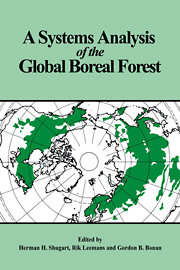Book contents
- Frontmatter
- Contents
- List of contributors
- 1 Introduction
- Part 1 Processes in boreal forests
- Part 2 Patterns in space and time in boreal forests
- Introduction
- 7 The transition between boreal forest and tundra
- 8 The southern boreal–northern hardwood forest border
- 9 Transitions between boreal forest and wetland
- 10 Remote sensing technology for forest ecosystem analysis
- 11 The nature and distribution of past, present and future boreal forests: lessons for a research and modeling agenda
- Part 3 Computer models for synthesis of pattern and process in the boreal forest
- References
- Index
9 - Transitions between boreal forest and wetland
Published online by Cambridge University Press: 12 January 2010
- Frontmatter
- Contents
- List of contributors
- 1 Introduction
- Part 1 Processes in boreal forests
- Part 2 Patterns in space and time in boreal forests
- Introduction
- 7 The transition between boreal forest and tundra
- 8 The southern boreal–northern hardwood forest border
- 9 Transitions between boreal forest and wetland
- 10 Remote sensing technology for forest ecosystem analysis
- 11 The nature and distribution of past, present and future boreal forests: lessons for a research and modeling agenda
- Part 3 Computer models for synthesis of pattern and process in the boreal forest
- References
- Index
Summary
In the boreal zone, precipitation exceeds evaporation and the forests are inclined to be paludal. There are two contradictory points of view regarding the nature of the transitions between boreal forest and bog. The first such view conceives of irreversible paludification of the forests due to the advancement of bog and self-paludification of the forests. The second surmises a dynamic equilibrium between forest and bog shown initially by the general lessening of the paludification process in recent times and secondly by the periodic afforestations of bogs and the depaludification of paludified forests.
The transitions between boreal forest and bog may be represented as a phytocenotic, continual series of ecosystems. Transitions among these ecosystems are reversible in time and space. A paludification series consists of automorphous forest → paludal forest → bogged forest → treed bog → open bog → regressive lake-bog complex; a series of depaludification is regressive lake-bog complex → secondary open bog or secondary treed bog → secondary bogged forest → automorphous forest. This work covers the latitudinal belt of taiga of the West Siberian Plain (Fig. 9.1) that consists of northern-, central-, southern- and subtaiga subzones and is limited by permafrost in the north and soil salinity in the south.
Major works on the transitions between forest and bog
According to Sukachev (1914a), there are two opposite pathways of mire evolution. The first pathway involves intensification of moistness with peat accretion and an eventual transition to ombrogenic supply (Abolin 1914).
- Type
- Chapter
- Information
- A Systems Analysis of the Global Boreal Forest , pp. 241 - 266Publisher: Cambridge University PressPrint publication year: 1992
- 6
- Cited by



